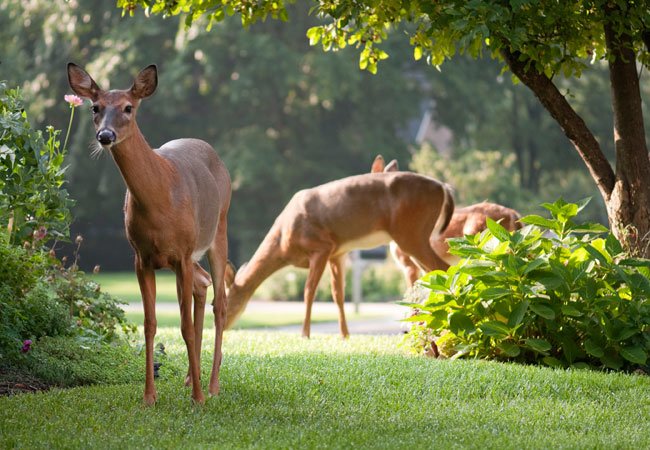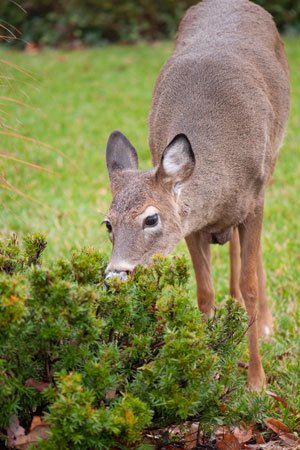

We may earn revenue from the products available on this page and participate in affiliate programs. Learn More ›
Deer are delightful romping through the forest but can wreak havoc in a garden, decimating vegetables, fruit trees, landscaping beds, even “deer-resistant” shrubs and pine and holly trees if they’re hungry enough. Commercial deer repellents tend to be pricey, so why not mix up your own, using ingredients you no doubt already have around the house? Follow our inexpensive, all-natural recipe for homemade deer repellent and then use as directed to keep Bambi and his buddies away!
WHAT YOU’LL NEED
– Garden sprayer (or large spray bottle)
– Warm water (1 gallon)
– Eggs (3)
– Milk or yogurt (3 tablespoons)
– Crushed garlic cloves (3)
– Cayenne pepper (3 tablespoons)
– Blender
– Strainer
Step 1: Blend all ingredients.
Put eggs, milk or yogurt, garlic, and cayenne pepper along with two to three cups of water into a blender, and puree thoroughly. Strain that mixture into a gallon jug, add the remaining water and seal.
Step 2: “Ripen” the mixture.
While the homemade deer repellent can be used immediately, it will be more potent if left to ripen at room temperature for 24 hours. Yes, it will be stinky! Transfer to garden sprayer or spray bottle.

Step 3: Spray the solution.
Spray plants liberally after morning dew or any rainfall has fully dried. Make sure to spray the entire plant, leaves, stems, fruits, and all. Don’t worry, it won’t harm your foliage, just make it smell and taste bad to foraging deer. Milk products contain a sticky protein called casein to help the homemade deer repellent cling. Once dry, the odor will be undetectable to humans but still unpleasant to ruminants. And should any stubborn invaders go beyond a sniff to a taste, that cayenne pepper will deliver a burning warning sure to turn them off!
Step 4: Store it properly.
The sticky homemade deer repellent could clog your spray dispenser, so after dosing your garden, pour any remaining mixture back into the jug for storage in the garage or a cabinet. As the eggs and milk continue to rot, it will get even more potent!
Step 5: Reapply as necessary.
Reapply the homemade deer repellent weekly and after any rainfall. Ideally, you’d begin spraying early in the growing season, as soon as the weather warms up in March and April. During this time, deer are establishing their feeding patterns and your plants are breaking winter dormancy. If you make your yard unappetizing to them from the get-go, they’ll find more hospitable grazing ground and may steer clear of your place.
Repellents (like this one) that contain garlic and egg solids often work effectively against not only deer, but other destructive garden interlopers as well—rabbits, skunks, groundhogs, and even some birds, such as crows. You may be able to discourage an entire scourge of critters with this potent homemade blend!
